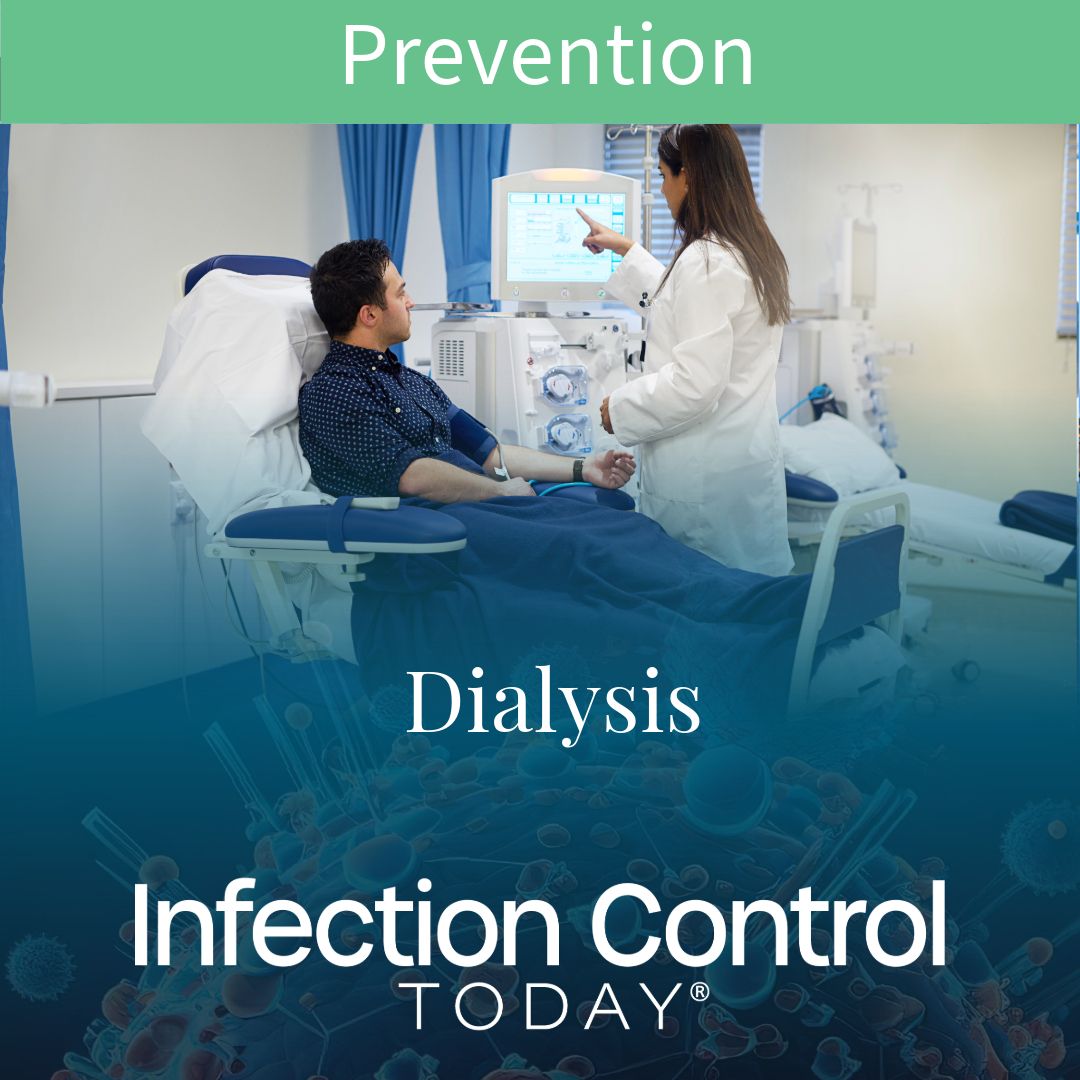Silent Threat: The Overlooked Infection Crisis in Dialysis Patients
Patients undergoing dialysis are especially vulnerable to infection due to weakened immunity, invasive access procedures, and frequent hospitalizations, making stringent infection control essential.
Man, doctor, and dialysis machine
(Adobe Stock 867731678 by Penn/peopleimages.com)

The immunocompromised host is a person with impairments in the body’s normal defense mechanisms against infection.1 Patients who are immunocompromised are susceptible to bacterial, fungal, viral, and parasitic infections that healthy immune systems usually overcome. They are also more susceptible to complications from common infections.2
Unfortunately, many patients requiring dialysis are at a higher risk for acquiring infection due to critical illness and multiple comorbidities such as diabetes, heart disease, and immunosuppression. Along with comorbidities, these patients will also require some form of invasive access into their vascular system or peritoneal cavity.3 Any failure along the spectrum of dialysis treatment, from staff education and hand hygiene to machine and station disinfection, will increase a patient’s risk for infection or adverse reaction.
Patients with end-stage kidney disease (ESKD) treated with hemodialysis (HD) are at substantially increased risk of life-threatening infections. Most bloodstream infections are related to vascular access, of which 70% are associated with using a central venous catheter (CVC).1 Infections result in significant morbidity and are second only to cardiovascular diseases as a cause of mortality in patients with ESKD. In addition, lapses in infection control practices, such as hand hygiene and environmental cleaning, have been associated with bloodstream infections and hepatitis C virus (HCV) outbreaks.
The role of infection preventionists in mitigating the risk of infections in patients undergoing dialysis is highly challenging due to multiple factors such as the immunocompromised state of patients, underlying medical conditions, frequent hospitalizations, exposure to vascular access for cannulation, central line access, contamination of dialysis water, risk of transmission of blood-borne viruses (BBVs), recurrent bloodstream infections, antimicrobial resistant colonization of methicillin-resistant Staphylococcus aureus (MRSA), multidrug-resistant organisms, and many more.4 Infection risk assessment is the keystone of prevention for patients who are immunocompromised and are undergoing dialysis, leading to implementing preventive actions in their treatment plans.5 The following preventive strategies are highly effective and recommended as a comprehensive approach to combat infections in this vulnerable population.6
1. Consistent Implementation of Standard Precautions
Effective hand hygiene, glove use, and environmental surface disinfection can prevent contact transmission. An adequate number of easily accessible handwashing sinks should be available (one for every 2 to 4 chairs/beds).6 An alcohol hand rub device (wall-mounted dispenser or desktop pump bottle) should at least be available for every patient’s chair/bed. During HD, exposure to blood and potentially contaminated items is routinely anticipated and gloves are required when caring for a patient or touching the patient’s equipment. Wearing fluid-resistant gowns, face shields, protective eyewear, and surgical masks is highly recommended to protect staff during initiation and termination of the dialysis sessions, insertion of a dialysis catheter, manipulation of patient’s access at any time, and cleaning of the dialysis station.6
2. Transmission-Based Precautions
Prompt implementation of transmission-based precautions for patients at increased risk for transmission of pathogenic bacteria, including antimicrobial-resistant strains (eg, those infected or colonized with MRSA or vancomycin-resistant Enterococci), and additional precautions (ie, contact precautions) must be followed during the dialysis session. To prevent the transmission of respiratory infections among patients undergoing HD, including COVID-19, appropriate droplet/ airborne precautions are necessary.6 Patients should be screened through a triage clinic before entering dialysis units and isolated based on their infectious status.6
3. Aseptic Technique
Restrict the use of standard supplies, medications, instruments, and medication trays, and avoid using a standard medication cart. Single-use medication vials should be used whenever available.6 When a multidose vial is used, dedicate it to a single patient whenever possible. If the multidose medication is brought to the patient treatment area, it should be discarded and not returned or used for another patient. The vial should be discarded if sterility is compromised or questionable.6
4. Cleaning and Disinfection of Surfaces and Equipment
After each patient treatment session, all surfaces at the dialysis station should be cleaned and disinfected with hospital-approved, US Environmental Protection Agency–registered intermediate-level disinfectant. Special attention and focus should be paid to the control panels on the dialysis machine and other surfaces that are frequently touched and potentially contaminated with the patient’s blood. Proper contact time (per manufacturer) of disinfectant is crucial to ensure maximum efficacy of the product.6
5. Immunization and Screening
Annual immunization against influenza is recommended for patients with ESKD who are at increased risk of complications from influenza. Routine immunization against hepatitis B virus (HBV) is recommended for all patients with ESKD (ideally before starting HD) and all staff members.4 Hepatitis B surface antigen (HBsAg) and hepatitis B surface antibody (HBsAb) titers should be obtained before starting dialysis, and HBsAg titers should be checked monthly if HBsAb titers are not at the desired level (nonresponders). Additionally, vaccinations for pneumococcal pneumonia, shingles, and SARS-CoV-2 are highly recommended for all patients undergoing dialysis.4
6. Prevention of BBVs
The transmission of HBV and HCV in HD units has been documented. Compliance with hand hygiene practices and glove use continues to be the most effective way to prevent the transmission of BBVs in dialysis units. Dedicated separate rooms for treatment of patients infected with HBV are mandatory. Designated machines, equipment, instruments, medications, and supplies should be used exclusively for patients infected with HBV (ie, they will not be used by patients susceptible to HBV-susceptible patients). There is no consensus to segregate patients with HCV and those with HIV; transmission between patients within the dialysis environment can be prevented by strict compliance with the infection control precautions (ie, standard precautions) recommended for all patients undergoing HD.5
7. Prevention of Vascular Access and Bloodstream Infections
Arteriovenous fistula (AVF)/arteriovenous graft access should be encouraged to reduce central line–associated bloodstream infections. Sterile preparation of the skin over the fistula site (creation of sterile field, use of sterile barriers and sterile gloves) is not more effective in preventing infection than clean technique (clean barriers and clean gloves with strict attention to aseptic technique).6 All patients should be encouraged to wash their access site with soap and water daily before the HD session. If a catheter must be used for access for longer than 3 weeks, a tunneled, cuffed CVC should be used (if possible, it should not be placed on the same side as a maturing AVF access point).6 The preferred insertion site is the right internal jugular vein. Catheters should be inserted using maximal sterile barrier precautions. Emphasis should be placed on the principles of asepsis when accessing or caring for central venous access. Chlorhexidine is highly recommended as an antiseptic for cleaning and disinfecting the vascular access of patients undergoing dialysis.5
8. Dialysis Events Surveillance
Measuring and tracking infection rates and using this information are essential to infection prevention in patients undergoing dialysis. This surveillance occurs in outpatient HD centers where patients are monitored and reported for 3 defined events: use of intravenous antimicrobials, positive blood culture results, and pus, redness, or increased swelling at the vascular access site.7 Reviewing dialysis event data and running analysis reports should be done regularly to prevent bloodstream and vascular access infections and be used for quality improvement initiatives.7
Conclusion
The incidence of serious infections among patients receiving maintenance HD remains unacceptably high. Acquisition of infections in HD facilities is often due to suboptimal infection control practices, and 100% use of recommended infection control guidelines is essential to prevent infections in this vulnerable population.4 Prevention efforts may require that HD organizations devote more significant resources to ensure the implementation of infection control practices. To lead these efforts successfully, medical directors and other nephrologists must understand and champion the CDC infection control practice guidelines. When nephrologists lead by example and collaborate closely with nursing management and staff, we may achieve our target of zero preventable infections and reduce infection-related morbidity and mortality.4
REFERENCES
1. Flood A. The immunocompromised host. In: APIC Text. Association for Professionals in Infection Control and Epidemiology; 2014. Accessed January 23, 2025. https://text.apic.org/toc/microbiology-and-risk-factors-for-transmission/the-immunocompromised-host
2. Bula-Rudas FJ. Infections in the immunocompromised host. Medscape. Updated May 22, 2024. Accessed January 23, 2025. https://emedicine. medscape.com/article/973120-overview
3. Garcia-Houchins S, Rindels J. Dialysis. In: APIC Text. Association for Professionals in Infection Control and Epidemiology; 2014. Accessed January 23, 2025. https://text.apic.org/toc/infection-prevention-for-specialty-care-populations/dialysis
4. Vijayan A, Boyce JM. 100% use of infection control procedures in hemodialysis facilities: call to action. Clin J Am Soc Nephrol. 2018;13(4):671-673. doi:10.2215/CJN.11341017
5. Guidelines, recommendations and resources. CDC. January 21, 2024. Accessed January 23, 2025. https://www.cdc.gov/dialysis-safety/hcp/recommendations-resources/index.html
6. Alkelany A, Tawfeeq S, Al Slaleh A, Assiri Y, Alshawaiqi A. Infection Control Guidelines in Hemodialysis Units. Ministry of Health of Saudi Arabia. November 2020. Accessed January 23, 2025. https://jed-s3.bluvalt.com/psj1-ifn-s3-ifn01/files/03/ Guidelines/Infection-Control-Guidelines-in-Hemodialysis-Units.pdf
7. Dialysis Events Surveillance Protocol. National Healthcare Safety Network. January 2024. Accessed January 23, 2025. https://www.cdc.gov/nhsn/pdfs/ pscmanual/8pscdialysiseventcurrent.pdf
Robust infectious disease surveillance, including rapid subtyping of influenza A, is essential for early detection, containment, and public health reporting of novel viral threats.
